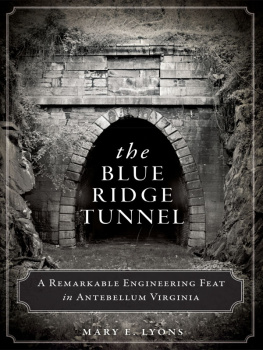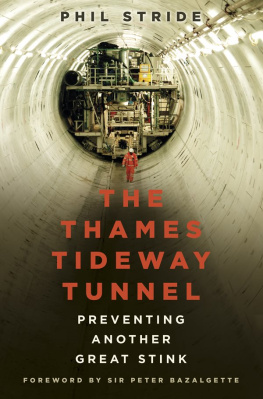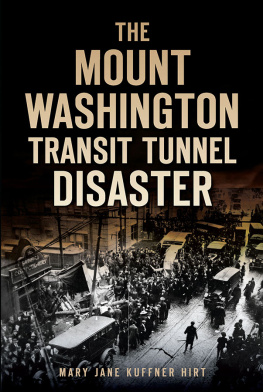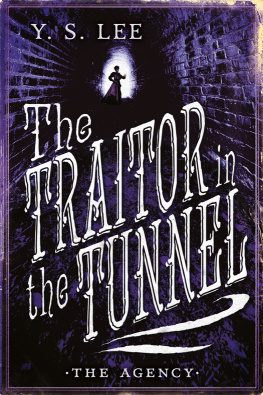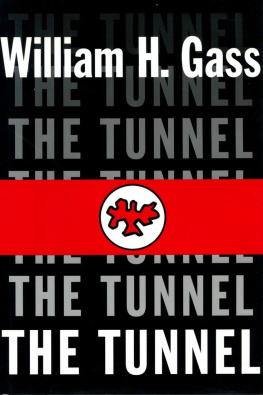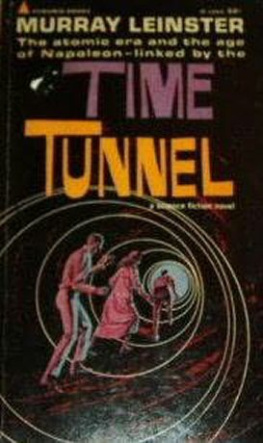
Published by The History Press
Charleston, SC 29403
www.historypress.net
Copyright 2014 by Mary E. Lyons
All rights reserved
First published 2014
e-book edition 2014
ISBN 978.1.62584.952.6
Library of Congress Cataloging-in-Publication Data
Lyons, Mary E.
The Blue Ridge Tunnel : a remarkable engineering feat in antebellum Virginia / Mary E. Lyons.
pages cm
Includes bibliographical references and index.
print edition ISBN 978-1-62619-421-2
1. Blue Ridge Tunnel (Va.) 2. Railroad tunnels--Blue Ridge Mountains--History--19th century. 3. Chesapeake and Ohio Railway. 4. Blue Ridge Railroad. I. Title.
TF238.B6L96 2014
624.19209755493--dc23
2013050144
Notice: The information in this book is true and complete to the best of our knowledge. It is offered without guarantee on the part of the author or The History Press. The author and The History Press disclaim all liability in connection with the use of this book.
All rights reserved. No part of this book may be reproduced or transmitted in any form whatsoever without prior written permission from the publisher except in the case of brief quotations embodied in critical articles and reviews.
Dedicated to Donald Harrington, a Blue Ridge Tunnel descendant who represents the spirit of Irish American generosity.
Contents
Preface
Newspapers in the 1850s invariably referred to the Blue Ridge Tunnel by that name. Burial records kept during the 1850s at Thornrose Cemetery in Staunton, Virginia, contain the same phrase. Most important, Irish immigrants writing to or from the Virginia Blue Ridge Railroad while searching for lost relatives referred to the Blue Ridge Tunnel in newspaper advertisements. For historical accuracy, then, I use the original name rather than the more recent names of Crozet Tunnel or Afton Tunnel.
I also designate 1860 as the completion year for the Blue Ridge Tunnel. True, the first train steamed through the passage in 1858, but work was incomplete. Irish laborers continued to blast away rock in 1859, and one died in a tunnel explosion that same year. The last known person who worked on the Blue Ridge Tunnels construction was Irishman Tim Callaghan, as reported in the 1860 Nelson County, Virginia census.
I know of no extant photographs of the tunnel construction or the workers. I have included examples of similar scenes so that readers can understand the difficulty of life at the tunnel and along the tracks. These are representational images, not actual photographs of the Blue Ridge Tunnel or the laborers.
Dean Merrin in America Transformed: Engineering and Technology in the Nineteenth Century; Selections from the Historic American Engineering Record states that the Blue Ridge Tunnel was the longest railroad tunnel in the world upon completion. However, William Lowell Putnam writes in Great Railroad Tunnels of North America that the first bore of the Woodhead Tunnel, completed in England in 1845, was almost three miles long.
The summit of the mountain at Rockfish Gap is 2,418 feet above sea level. The Woodhead summit in the United Kingdom, where a mountain is defined as 2,000 feet or more above sea level, is 966 feet. I have concluded, then, that the Blue Ridge Tunnel was the longest mountain railroad tunnel in the world upon completion.
The following good souls helped in a variety of ways as I researched and wrote this book. I thank Paul Collinge, Jane C. Smith, Arthur Collier, Allen Hale, Margaret and Molly Ryther, Jane Harrington, Nancy Sorrels, Linda Petske and her marvelous students, Katherine McNamara, Mary Lee Dunn, Gene Carlson, Myra Horgan, Michael Aukofer, James E. Gage, Gary Rogers, Mac Beard, Debra Weiss, Vesta Gordon, Mardi Brownell, Pam Hardy, Sam Towler, Bob Vernon and Jim Kauffman.
To my research colleagues in Ireland, I offer special thanks for their encouragement, curiosity and generous sharing: Flan Enright, Pat OBrien, Denis Callahan and Charlie Coughlan.
I am especially grateful to the Virginia Center for the Humanities for a residential fellowship that allowed me to complete a draft of the book in the fall of 2011. The staff and other fellows were supportive at all times, especially Ann Spencer, Susan McKinnon, Jamie Ross, Bill Freehling, Jerry Handler and Hilary Holladay.
To all, go raibh maith agat. Thank you.
Mary E. Lyons
Charlottesville, Virginia
December 2013
PART I
A Narrative History of the Blue Ridge Tunnel
Prologue
Ticks. Mosquitoes. Chiggers. Snakes. Its a sticky hot day in 1976. Two men are battling the beasts of summer as they hike along a grassy trail. This is no ordinary path through the forest. Its an old railroad track bed, built between 1850 and 1860 at Rockfish Gap, Virginia. Made of blasted rock, the track bed is 135 feet high and 700 feet long.
Minutes later, the men round a bend. They come upon an eye-popping sight: the east portal of the Virginia Blue Ridge Tunnel. The opening looks like the gaping jaws of a sleeping giant. Its mouth is smeared with more than one century of locomotive soot. Water from mountain springs drools down both sides. Vertical drill holes in the rocky approach to the portal are long and smooth, like teeth.
The visitors to the tunnel on this sweltering day are members of the American Society of Civil Engineers. The society has recently decided that the Virginia Blue Ridge Tunnel was one of the greatest engineering marvels of the nineteenth century. It has declared it a National Historic Civil Engineering Landmark.
Other winners of this prestigious award are the Statue of Liberty, Washington Monument, Panama Canal and Eiffel Tower. The society plans to erect a bronze plaque in honor of the historic tunnel. Thats why the engineers are here todayto inspect the passage and decide where to put the plaque.
The body of the Blue Ridge Tunnel is 16 feet wide, 20 feet high and 4,237 feet long. The longest mountain railroad tunnel in the world when finished, its a Goliath in American railroad history. The passage slices through the belly of the mountain, straight as a knife. The inside is inky dark, with a chilly temperature of fifty-five degrees. A steady stream of cold water runs along the floor.

East portal of the Blue Ridge Tunnel. No arch was necessary to support the granite at the east portal. Authors collection.
As the men slosh through it, their flashlights cast an eerie glow on the ceiling. One engineer shines his light on the tunnel walls. Layers of bricks cling to them like scaly skin. Ill bet there arent three men in this country, he says with awe, who could do that kind of work now.
There arent many people who would do that kind of work now. But back in the 1840s and 1850s, almost two million Irish men and boys were desperate for jobs, no matter how difficult they might be. When railroad construction exploded across America, railroad companies needed people willing to work for a beggars pay, and they knew just where to find them.
Tragically, a catastrophe in Ireland called the Great Hunger brought American railroad companies great luck. Without the Great Hunger, the Blue Ridge Tunnel would never have been built.
184549
Irelands Great Hunger began when a plant fungus blew in on the wind in 1845. The fungus withered the stalks of potato vines and scorched the leaves, as if someone had lit a match to the plants. When Irish farmers dug up the potatoes, they found black tubers that smelled like raw sewage.
Next page
